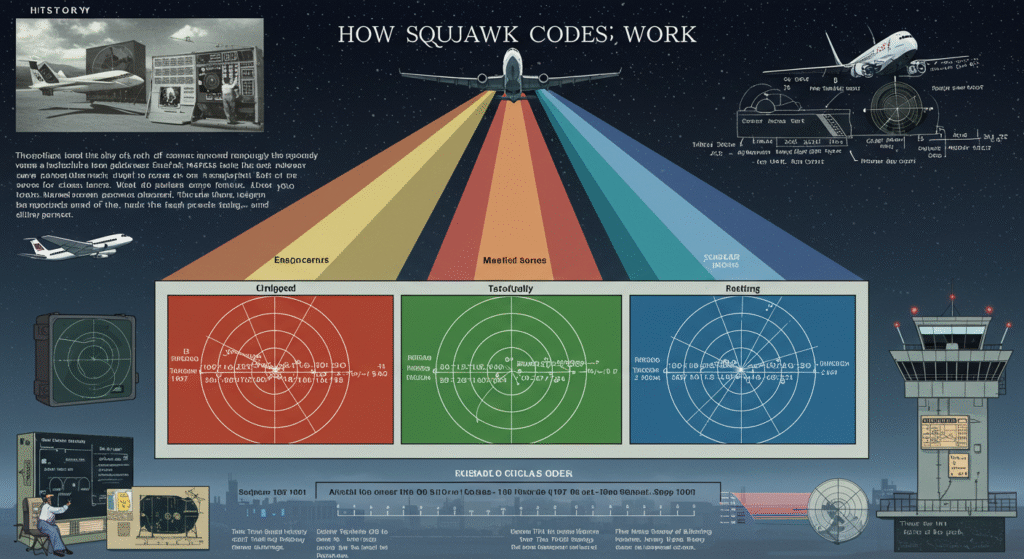Disclaimer: This article uses information about aviation squawk codes as of August 15, 2025. Details may change with new research or updates from aviation authorities like the FAA and EASA. This is for learning only. It does not give final answers. Check official sources for the latest facts.
Introduction: What Are Squawk Codes?
Squawk codes are special numbers. Planes use them to talk to air traffic control. These codes help during emergencies. They send signals through a device called a transponder. The transponder is like a radio on the plane. It tells controllers what’s happening. For example, it can say the plane has a problem.
These signals are a hidden language. Pilots use them to ask for help. Air traffic control sees the codes and acts fast. This keeps everyone safe in the sky. I’m Jennifer Marshall. I’ve written stories for nine years. I love explaining big topics like this in simple words. This article will show you how squawk codes work. It will cover their history, meanings, and more.
The Origin of Squawk Codes
How It All Started
Squawk codes began long ago. They started after World War II. Planes needed better ways to talk. Radars were new back then. They helped track planes. But radars needed more information. So, experts created transponders. These devices send codes to radars.
In the 1950s, the International Civil Aviation Organization (ICAO) made rules. They picked four-digit codes. Each number had a meaning. This made communication clear worldwide. It was like giving every plane a special phone number. The system grew as flying became busier.
Why Codes Matter
Before codes, pilots used radios to talk. This was slow and hard. Bad weather or noise made it worse. Squawk codes fixed this. They let planes send signals quietly. Controllers could see problems right away. This history shows how smart the system is.
The Three Most Critical Squawk Codes
7700 – General Emergency
The code 7700 means a big problem. It can be anything serious. Maybe the plane has engine trouble. Or a passenger is very sick. Pilots enter this code to get help fast. Air traffic control sees it and clears the runway. For example, a plane might land early if 7700 is used. This code was notable in incidents like the United Airlines Flight UA770 Emergency Diversion.
7500 – Unlawful Interference (Hijacking)
The code 7500 is for hijacking. This means someone bad is on the plane. They might try to take control. Pilots use this code secretly. It tells controllers without the hijackers knowing. Then, police and military get ready to help. It’s a quiet way to ask for rescue.
7600 – Radio Communication Failure
The code 7600 means the radio stopped working. Pilots can’t talk to controllers. This is dangerous in busy skies. The code lets controllers know. They watch the plane closely. Pilots follow hand signals or lights to land safely. This code keeps flying safe without words.
How ATC Responds to Different Codes
Steps for 7700
When controllers see 7700, they act fast. First, they clear the airspace. They move other planes away. Then, they find the nearest airport. They tell emergency teams to wait. The plane lands safely with help. This step-by-step plan saves lives.
Steps for 7500
For 7500, controllers stay calm. They don’t talk much. They alert police and the military. They guide the plane to a safe spot. No one tells the hijackers. The focus is on landing without trouble. This keeps passengers safe.
Steps for 7600
With 7600, controllers watch the plane. They use lights or signals to guide it. They keep other planes away. The pilot follows a set path to land. This works even without a radio. It’s a smart way to stay safe.
Technology Behind the Codes
How Transponders Work
Transponders are like brains on planes. They send codes to radars. Mode A transponders give a basic number. Mode C adds height information. Mode S is the smartest. It sends detailed data, like the plane’s name. Pilots set the code, and it beams to controllers.
Future Tech Developments
New technology is coming. Satellites might replace radars. This could make codes better. Planes might send more details, like fuel levels. Experts are testing these ideas. It could make flying even safer in the future.
Examples of Squawk Codes in Action
Medical Emergency
One time, a plane used 7700 for a sick passenger. The flight was over the ocean. A doctor on board helped, but the person needed a hospital. The plane landed early in Ireland. Doctors were waiting. The passenger got care fast.
Technical Malfunction
Another plane used 7700 for a broken engine. It was flying over Europe. The pilot saw smoke. The code told controllers. The plane landed in Germany. Workers fixed it, and no one was hurt. The code worked well.
Why Passengers Rarely Notice Squawk Codes Being Used
Quiet Work by Crew
Pilots and crew handle codes quietly. They don’t tell passengers right away. They want to avoid panic. The captain might say, “We’re landing early for a check.” This keeps everyone calm. The process happens behind the scenes.
Fast Actions
Controllers and pilots work fast. They solve problems before passengers notice. Emergency teams are ready on the ground. Passengers only see a smooth landing. This teamwork makes flying feel safe.
Conclusion: Silent Signals That Save Lives
The Hidden Language of the Skies: Understanding Aviation Squawk Codes and Their Meaning is amazing. Codes like 7700, 7500, and 7600 help planes in trouble. They send silent signals to save lives. Pilots, controllers, and technology work together. This keeps the sky safe every day.
I’m Jennifer Marshall. I’ve written stories for nine years. I love sharing clear facts like this. Squawk codes show how smart aviation is. Next time you fly, know these signals are there. Have you seen a plane land early? Share your story with us!
Disclaimer: This article uses information about aviation squawk codes as of August 15, 2025. Details may change with new research or updates from aviation authorities like the FAA and EASA. This is for learning only. It does not give final answers. Check official sources for the latest facts.

Jennifer Marshall is a friendly and talented journalist who loves telling stories. She is an expert in writing biographies that make people’s lives shine. With clear and simple words, Jennifer creates engaging stories that everyone can enjoy. With 9 years of experience, her passion for writing helps her connect with readers and share inspiring tales.
